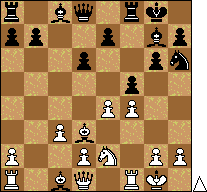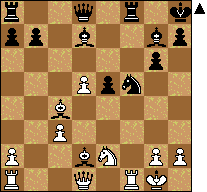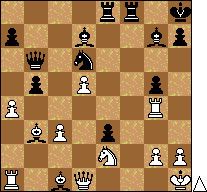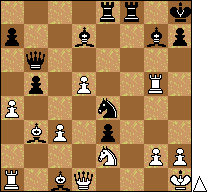Round 1 of Pittsburgh Chess Club tournament: revenge of the Knight
Nov 13, 2012 · 6 minute read · CommentschessPittsburghPittsburgh Chess ClubSicilian Defense

Panoramic view of round 1
So I started another Pittsburgh Chess Club 6-round Tuesday night tournament, the 16th Robert P. Smith Memorial. (I reported on my previous Tuesday night tournament here.)
Today’s lesson
In my game for round 1, we see the power of a good Knight, especially in contrast to a bad Bishop.
The complete annotated game
At your convenience, you can enjoy playing over the game with my annotations, including diagrams.
Preparation
Since this was round 1, there was no telling in advance who my opponent would be. So I had no preparation other than just having played a Pittsburgh Chess League game on Sunday. Surprisingly, that experience did prove useful in my game, as I will explain.
Strength
I expected to be the highest-rated player in the tournament again, as in the last one, so I expected that round 1 would pair me against someone considerably lower-rated than me. As usual, however, I respect all of my opponents, regardless of rating. Upsets do happen, especially when one does not take an opponent seriously.
It turned out that I was paired against someone I had never actually met before, much less played against. I enjoyed this situation, as it meant unpredictability. There is something to be said for the pleasures of refining one’s way of playing against an opponent one has faced before, but there is also something to be said for totally real-time improvisation.
The game ended up long, taking over three hours to complete. It wasn’t just a quick and easy win, despite my opponent being 500 rating points lower than me.
Overview of my game
The opening
As I had Black, I was of course much more limited in my choice of opening than I am as White. As I did in round 2 of the previous tournament, I countered e4 with the aggressive Sicilian Defense.
My opponent played the Grand Prix Attack. White’s goal in this variation is to focus on launching a King side attack against Black, by playing an early f4, with the plan of eventually playing f5, bringing the White Queen to e1 and h4, etc. This attack often works effectively on weaker players, but objectively, Black can defend against it.
He chose an unusual sub-variation I had not seen before, Bd3, after which I made a positionally rather risky decision that I would not make again, but just happened to feel like engaging in at the time: I decided to develop my King Knight not to a “normal” square such as f6, but to the “rim” at h6 instead:

Knight on h6
My justification was that I wanted the option of playing my own attack with f5. I was in the mood for dynamic complications rather than a more sedate middle game:

After f5
The middle
White made a strategic mistake in allowing my Knight on h6 to get to a great outpost on f5:

Knight on f5
The position was still roughly equal at this point, but gradually White made more inaccurate moves, ceding an advantage to me. In fact, by the position, I already had a won game (but missed the best continuation):

White is actually lost
Note how poor White’s Bishop on d2 is, while Black’s Knight on f5 is clearly the strongest of all the remaining minor pieces (four Bishops and two Knights).
In the following position, I have just played the Pawn advance e4:

e4 advance by Black
The good Knight
Perhaps White had thought that I would play Ne3 trading my Knight for White’s Bishop on d2. No! I was not going to make the mistake again of thoughtlessly trading a good Knight for a bad Bishop, the way I just reported on doing so on Sunday! Both common sense and tactical calculation rebel against such an idea.
In fact, in the game I proceeded to make White’s bad Bishop even worse:

White's Bishop back on c1
The end
In the final blow in the game, I set a trap, offering White a “free” Pawn, which he mistakenly took (but I had a completely won position anyway; this is not “hope chess” where an idea only works if you hope your opponent falls into a trap). I moved the Knight from f5 to d6, not only threatening White’s Rook, but also with the intention of redeploying the Knight to e4 and then f2. And I did so.

White's Rook threatened and trap set

White's Rook trapped
White struggled on for a few more bizarre moves before resigning:

White resigned
Lessons learned
- Because of my game on Sunday (and reflections on previous games before that), I was very conscious of the power of the Knight and wanted to use it well.
- My anti-positional
f5idea “worked”, and created an interesting position and middle game out of which I did well, but I feel guilty about having played this milder version of “hope chess”. - Sometimes it’s not clear to a bystander how much thought actually goes into a sound attack, because the vast majority of calculations during an attack inevitably go into thinking about possible continuations that never happen during the game, but must be evaluated in case they do happen. (See the annotations for some details of the alternative lines that did not happen.)
- I did miss a faster, more immediate win (see the annotations for details); this is something I sometimes do when I have a clear advantage and end up with a little bit of tunnel vision in which I initially see too many good moves, and instead of investigating them all thoroughly, I investigate one, decide it is good, and then go with it. How to zoom in more effectively is an ongoing problem to solve.
What next?
Next week for round 2 I will get a stronger opponent, but play White. For reasons I’ll explain after the fact, I’m thinking of playing completely differently with White than I have in the past Tuesday night tournament and in the Pittsburgh Chess League so far! Stay tuned. I want to explore some themes so that I can write about them.
Conclusion
I got off to a good start in the Tuesday night tournament with an interesting game in which I played a fairly precise attack. And I was happy, after abusing my Knight in Sunday’s game, to make my Knight the hero of the first Tuesday night round. I must remember to love each of my pieces in each game I play.